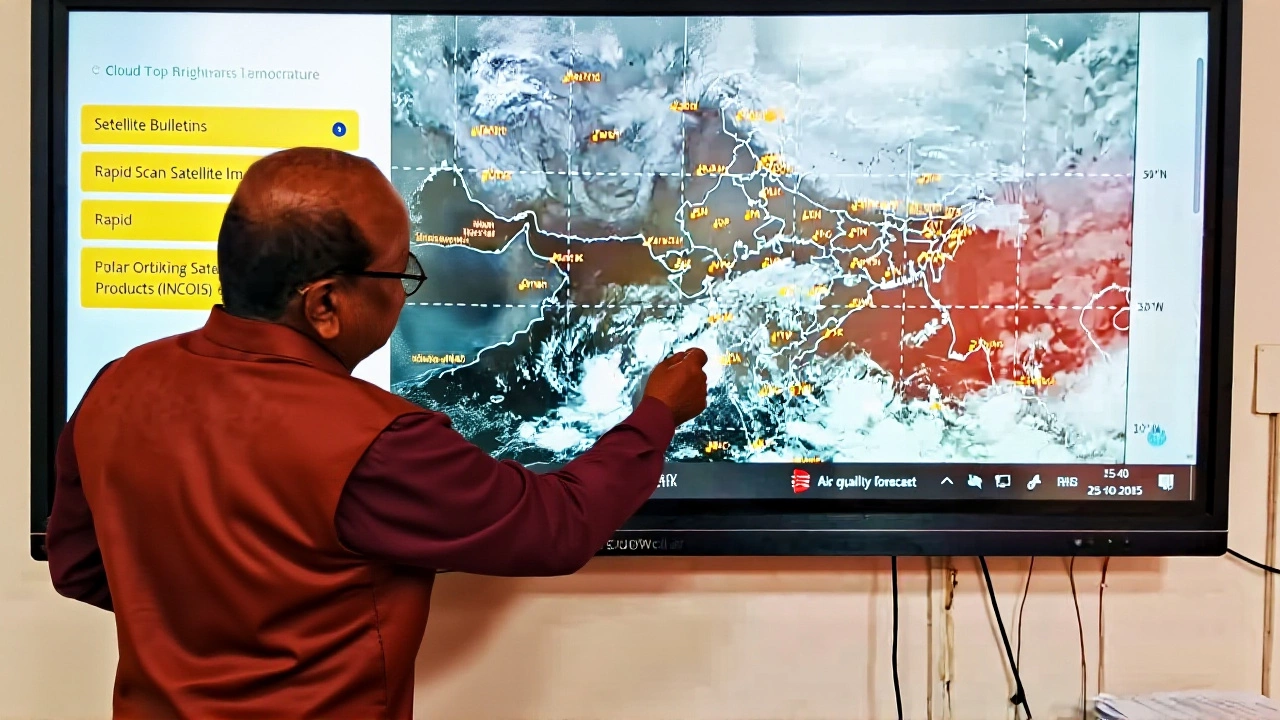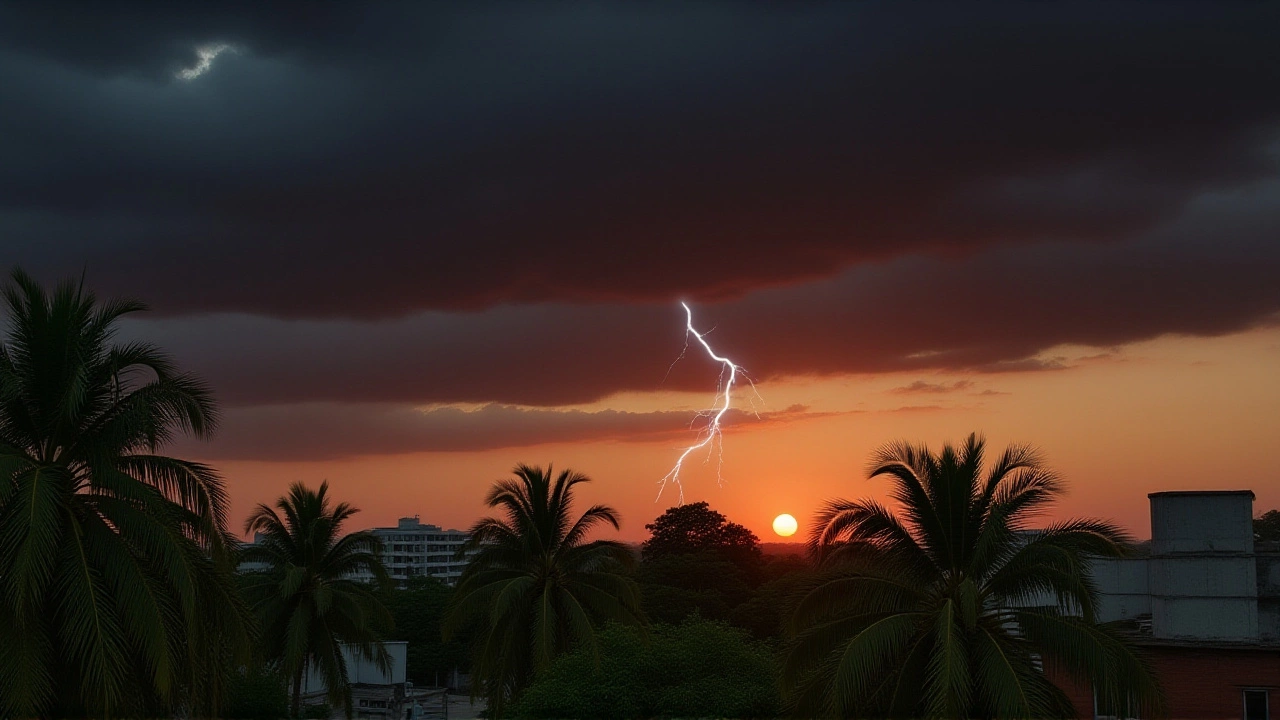When India Meteorological Department (IMD) issued a heavy rainfall alert for Jharkhand from October 28 to 31, 2025, few expected the storm to collide with one of the state’s most sacred festivals. The culprit? Cyclone Montha, a powerful system brewing in the Bay of Bengal and named by Thailand, is now barreling toward India’s eastern coast — and its tailwind is set to drench Jharkhand just as millions prepare to offer prayers to the sun god during Chhath Puja.
The Storm’s Path and Intensity
Developing from a low-pressure zone on October 25, 2025, Cyclone Montha rapidly intensified into a deep depression by October 26, then a cyclonic storm by the morning of October 27. By October 28, it’s expected to become a severe cyclonic storm with sustained winds of 90–100 km/h and gusts up to 110 km/h. The center is forecast to make landfall between Kakinada and Puri, near Machilipatnam and Kalingapatnam in Andhra Pradesh, on the evening of October 28.
Even before landfall, the system is already sending ripples inland. The Indian National Centre for Ocean Information Services (INCOIS) warned of 4.7-meter-high ocean waves along the Andhra coast. Meanwhile, rainfall bands are spreading northward — already soaking parts of Odisha, Tamil Nadu, and Chhattisgarh.
Jharkhand Braces for Impact
Though the cyclone’s eye won’t cross Jharkhand, its outer circulation is expected to unleash torrential rain across nine districts: Ranchi, Simdega, Khunti, Lohardaga, Gumla, Palamu, Garhwa, Chatra, and Hazaribagh. In Simdega, just 0.5 mm of rain was recorded in the past 24 hours — a deceptive calm before the storm. But from October 28 onward, IMD forecasts 100–200 mm of rainfall in 72 hours, with isolated pockets exceeding 250 mm.
“This isn’t just another monsoon spell,” said Dr. Amit Kumar, a senior scientist at the Ranchi meteorological center. “The moisture flow from the cyclone is locked in a persistent pattern. We’re talking about sustained downpours, not brief showers. Farmers need to act now.”
Chhath Puja Under Threat
For millions in Jharkhand and Bihar, Chhath Puja is more than ritual — it’s identity. Devotees stand waist-deep in rivers at dawn and dusk, offering arghya to the sun. But this year, the final day of the festival — October 30 — could be washed out. Local temple committees in Ranchi and Dumka have already begun relocating rituals to elevated platforms. In some villages, families are preparing tarpaulins and emergency lighting.
“We’ve been doing this for generations,” said Sunita Devi, a Chhath devotee from Khunti. “But I’ve never seen the sky so dark this early. My grandchildren are scared. We’re praying — but we’re also packing dry clothes and bottled water.”

Emergency Response in Motion
State disaster management officials moved fast. Jharkhand State Disaster Response Force (SDRF) and the National Disaster Response Force (NDRF) have deployed 12 fully equipped teams — 360 personnel total — across high-risk zones. Relief camps are being readied in low-lying areas of Palamu and Garhwa. Power and telecom teams are on standby, with mobile generators distributed to critical infrastructure.
“We’ve activated our full emergency protocol,” said Rajeev Arora, Secretary of the Jharkhand Disaster Management Department. “We’re not waiting for damage reports. We’re anticipating them.”
Agriculture in the Crosshairs
The state’s agriculture department has issued urgent advisories to over 1.2 million farmers. Rice, mustard, and potato crops — nearing harvest — are vulnerable. In Gumla, where farmers had just finished transplanting paddy, the risk of waterlogging is high. The department is advising immediate drainage and harvesting of mature crops before October 29.
“One good monsoon gave us hope,” said farmer Ram Prasad from Lohardaga. “Now this? We’re caught between blessing and curse.”

What’s Next?
The cyclone’s remnants are expected to linger until October 31, with residual rain and thunderstorms possible. IMD predicts a sharp drop in temperatures across eastern India by November 2, potentially triggering fog and reduced visibility on highways. The next 72 hours will be decisive — not just for safety, but for livelihoods.
Historical Context: How Rare Is This?
October cyclones hitting eastern India are uncommon but not unheard of. The last major October cyclone to impact Jharkhand was in 2019, when Cyclone Bulbul caused widespread crop damage and power outages. But Montha is stronger than Bulbul at this stage. Climate scientists note that warming Bay of Bengal waters are fueling more intense off-season storms — a trend that’s accelerated since 2020.
Frequently Asked Questions
How will Cyclone Montha affect Chhath Puja rituals?
Many Chhath devotees in Jharkhand are relocating rituals from riverbanks to elevated platforms or community halls to avoid flooding. Authorities are advising against standing in water during heavy rain due to risk of electric shock from submerged power lines. Some villages are delaying the final day of worship by 24 hours if conditions permit.
Which districts in Jharkhand are most at risk?
Ranchi, Simdega, Khunti, Lohardaga, Gumla, Palamu, Garhwa, Chatra, and Hazaribagh face the highest rainfall risk, with Palamu and Garhwa also vulnerable to landslides. IMD has flagged these areas as ‘red zones’ for emergency response. Rural roads in these districts are already showing signs of erosion.
What should farmers do to protect their crops?
Farmers are advised to harvest mature crops like mustard and potato immediately. For standing paddy, drainage channels must be cleared, and bunds reinforced. The state agriculture department has distributed 50,000 sandbags and 1,200 portable pumps to high-risk blocks. Delaying action could mean losing up to 70% of harvest in low-lying fields.
Why is Cyclone Montha forming so late in the year?
Warmer-than-average sea surface temperatures in the Bay of Bengal — 31.5°C compared to the 28°C average — are fueling off-season cyclones. Since 2020, four major cyclones have formed in October or November, up from just one in the previous decade. Scientists link this to climate change intensifying ocean heat absorption.
Are schools and offices closing in Jharkhand?
As of October 27, no statewide closure has been ordered, but district administrations in 12 high-risk districts have advised remote work and virtual classes from October 29–31. Local panchayats are coordinating with schools to use gymnasiums and community centers as emergency shelters if needed.
How long will the rainfall last after the cyclone passes?
Rainfall is expected to continue through October 31, tapering off gradually. However, residual moisture may trigger thunderstorms until November 2. The real danger post-cyclone is waterlogging and landslides in hilly areas like Khunti and Gumla, where soil saturation increases collapse risks for weeks.



